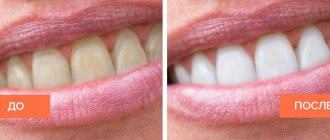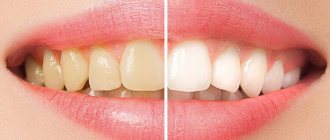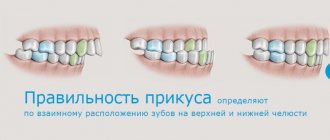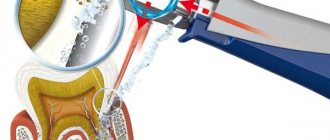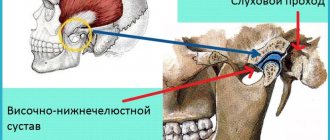Functions of the dental system:
- Chewing is the main function of the teeth and dentofacial system. Chewing is the first stage of the digestion process.
- Aesthetics. The dental system affects the appearance of the face. Teeth also play an important aesthetic role. The position, shape and shade of teeth have a significant impact on the formation of a person’s personality.
- Pronunciation. Teeth help us pronounce words correctly as they play an important role in the pronunciation of consonants. Missing teeth (especially the upper front teeth) or an incorrect bite can somewhat impair normal speech.
Teeth
Normally, a person has from 28 to 32 teeth. Why from 28 to 32? Because the so-called “wisdom teeth” erupt late, some may not erupt at all, or collapse after eruption, so their absence is considered normal.
In a person’s entire life, they change their teeth only once—from baby teeth (temporary) to molars (permanent). At the same time, both milk and molars are formed during intrauterine development.
Already at 6-7 weeks of pregnancy, the embryo begins to form a dental plate with the rudiments of milk teeth. There are 20 rudiments in total - 10 at the bottom and at the top. In the third month of development, cells of pulp, dentin and enamel are formed, and from the 4th month the tissues themselves are formed. Dental cement is formed already at 4-5 months of a child’s life.
During intrauterine development, the formation of molars also occurs - this occurs around the 5th month. The rudiments of molar teeth are located behind the rudiments of milk teeth.
The eruption of baby teeth begins 4-7 months after birth. When a baby tooth erupts, the formation of dentin and enamel begins in the molar tooth bud. The molar develops, grows, its enamel presses on the root of the baby tooth, which ultimately leads to resorption of the root. As a result, the baby tooth falls out, and a molar erupts in its place. Temporary teeth begin to be replaced by molars at 6-7 years of a child’s life, and this process ends, on average, at 14 years. The very last teeth to erupt are the third molars. These teeth can erupt at the age of 20.
Tooth structure
Any tooth is conventionally divided into three parts: the root, the neck of the tooth and the crown of the tooth. The root of the tooth is located in the alveolus of the jaw bone. The root is attached to the alveolus of the jaw bone by means of periodontal collagen fibers.
The neck of a tooth is a small area, the transition from the root to the crown.
The crown is the part of the tooth that protrudes above the surface of the gum.
The inside of the tooth is not solid - the dentin forms a cavity, identical in shape to the shape of the tooth. This cavity is filled with pulp. Conventionally, the coronal part of the cavity and the root canals are divided. The canals are through - in the region of the root apex they end at the apical foramen. It is clear that the number of canals of a tooth is equal to the number of its roots.
If we look at the tooth layer by layer, we will see:
- Pellicle. The topmost, thinnest layer. This is an organic film that covers the enamel and protects it from destruction.
- Enamel. This is a layer of hard, durable, smooth substance that covers the crown and neck of the tooth. The chewing surface of the tooth has the thickest layer of enamel, and the neck of the tooth has the thinnest. Enamel has a complex composition, which has not yet been reproduced today. Despite the fact that enamel is the hardest tissue in our body, it is easily attacked by acids and destroyed.
- Cement. This is the tissue that covers the root of the tooth and performs the same functions as enamel. In addition, cement provides reliable attachment of the tooth root to the periodontium. The cement is saturated with minerals and permeated with collagen fibers, due to which the tooth is attached to the periodontium.
- Dentine. This is the main tissue of the tooth, which is similar in structure to bone tissue, but only stronger, due to greater mineralization.
- Pulp. This is loose connective tissue. It fills the entire tooth cavity, both its coronal part and the root canals. The pulp contains blood vessels, lymphatic vessels, and nerves.
Classification of teeth
Teeth are classified according to many criteria:
- By lifespan: dairy and indigenous.
- By function: incisors, canines, premolars, molars. Premolars are also called small molars, and molars are called large molars.
- By the number of roots: single-rooted, double-rooted, triple-rooted. Single-rooted teeth include incisors, canines, and premolars; double-rooted teeth include molars of the lower jaw; three-rooted teeth include molars of the upper jaw.
- According to the shape of the crown (by the number of tubercles): single-tubercle, double-tubercle, multi-tubercle. Single-tubercles include canines and incisors, double-tubercles include premolars, and multi-tubercles include molars.
All teeth, regardless of type and type, are equally susceptible to various diseases and damage that can lead to tooth loss. Therefore, reducing factors such as poor nutrition, poor oral hygiene, abuse of certain pharmaceuticals, bad habits and increased trauma, and avoiding dental treatment will be the best guarantee of teeth preservation at any age.
Read more...
Return to news list Frequently asked questions about implantation
Types of teeth:
Typically, a person has 32 permanent teeth: 16 on the upper arch and 16 on the lower arch. Sometimes, due to genetic abnormalities, birth defects, or teething problems, more or fewer teeth appear.
The name of the teeth on each jaw is self-explanatory - the top sixteen are called "maxillary teeth" and the lower half are called "mandibular teeth".
Humans have different types of teeth that perform different functions such as cutting, tearing, grinding and crushing. The teeth are driven by the muscles of the jaw and lubricated by saliva, which is produced by the salivary glands.
Babies are born toothless because their main source of food is mother's milk. As children begin to wean, baby teeth gradually begin to emerge. Among the four types of teeth, the lower incisors are the first primary teeth to develop, and most children will have all twenty primary teeth by age 3. By the age of six, baby teeth are replaced by permanent teeth.
Adults have a total of 32 teeth, called permanent teeth:
- Eight incisors - four maxillary incisors and four mandibular incisors.
- Four canines - two canines on the upper jaw and two canines on the lower jaw.
- Eight premolars - four maxillary premolars and four mandibular premolars.
- Twelve molars - six molars in the upper jaw and six in the lower jaw. It also includes four wisdom teeth.
Teeth have different shapes because each tooth has a specific role during chewing and ultimately digestion. They are also placed at a specific location to better serve their purpose.
Signs of teeth. Dentofacial segments
Signs of teeth. The teeth of the same name on the right and left halves of the dental arches differ in structure. It is possible to determine whether a tooth belongs to the right or left half of the dental arches by three signs: the sign of the crown angle, the sign of the curvature of the crown enamel and the sign of the root (Fig. 1).
Rice. 1. Signs of teeth:
a - root sign; b - sign of crown angle; c - sign of crown curvature
Crown angle sign: in the vestibular norm, the angle formed by the occlusal surface and the mesial surface is sharper than the angle between the occlusal surface and the distal surface. The last corner is slightly rounded.
The sign of curvature of the crown enamel is determined when examining the tooth from the occlusal surface (normally), while the mesial part of the crown enamel on the vestibular side is more convex than the distal one. The enamel of the vestibular surface of the crown thickens in the mesial direction and has a steeper bend at the mesial edge than at the distal one.
The root sign is determined in the position of the tooth in the vestibular norm. If you draw the longitudinal axis of the crown (lower the perpendicular from the middle of the cutting edge) and the longitudinal axis of the tooth (from the apex of the root to the middle of the cutting edge), it turns out that the axis of the tooth is deviated laterally. Consequently, the direction of deviation of the longitudinal axis of the tooth indicates the side of the tooth.
The concept of dentofacial segments
As noted, the dentofacial segment combines the jaw area and the tooth with the periodontium. The segments of the 1st and 2nd incisors and canines are distinguished; 1st and 2nd premolars; 1st, 2nd and 3rd molars. The boundary between the segments is a plane drawn through the middle of the interalveolar septum.
The dentofacial segments of the upper and lower jaws include different components (Fig. 2). Thus, the incisive segments of the upper jaw include the alveolar and palatal processes. The dentofacial segments of premolars and molars contain the processes of the upper jaw with the lower wall of the maxillary sinus located in them.
Rice. 2. Dentofacial segments (according to L.V. Kuznetsova):
a - upper;
b - lower: I - segments of a narrow and long jaw; II - wide and short jaw segments
The basis of each segment is the alveolar process (for the upper jaw) or the alveolar part (for the lower jaw). The cross-section of the upper incisal segments in the sagittal plane is close to the triangle. In the area of the premolar- and molar-maxillary segments it is trapezoidal or approaches a rectangle. The outer and inner walls of the alveoli consist of a thin layer of compact substance, between them there is a spongy substance, in the alveolus lies the root of the tooth with periodontium. The outer wall of the alveoli is thinner than the inner one, especially in the area of the incisal and canine segments. The palatal process of the maxilla in the incisive and canine segments consists of the upper and lower plates of the compact substance and a layer of spongy substance between them, and at the level of the molar-maxillary segments - only of the compact substance or a compact and insignificant amount of spongy substance. The bone beams of the spongy substance are located mainly along the height of the jaw.
The cross-sectional shape of the incisal segments of the lower jaw in the sagittal plane is close to a triangle, the base of which faces downwards. In the area of the molars, the cross-sections of the segments have the shape of a triangle with the base facing upward; the shape of the premolar-maxillary segments approaches oval. The thickness of the compact substance of the alveolar part of the lower jaw and alveoli is individually different both in different segments and within each of them. The compact substance of the outer wall of the alveoli is greatest in the region of the molar-maxillary segments, and least in the region of the mental foramen. The thickness of the compact substance of the inner wall of the alveolus is greatest in the region of the canine segments, the smallest in the region of the molar-maxillary segments. The spongy substance of the lower jaw in its alveolar part consists of straight beams located vertically.
Dentofacial segments of the upper jaw. Incisor-maxillary segments. The height of the alveolar process in the incisal segments is 12.0-15.5 mm. The II incisal segment includes part of the frontal process. The thickness of the outer plate of the compact substance at the neck of the tooth is 0.35-0.65 mm, at the level of the root - 0.35-0.8 mm, and the inner one - 0.5-1.25 mm. The spongy substance, 0.15-2.3 mm thick, consists of long bone beams that are directed into the palatine and also into the frontal process. The cells are oval, oriented along the beams. The thickness of the compact substance of the alveolar wall is 0.15-0.6 mm. The periodontal gap at the root apex reaches 0.4 mm, and at the neck of the tooth - 0.2 mm. The thickness of the gum on the vestibular side is 0.5-0.9 mm, on the lingual side - 0.9-1.8 mm. The depth of the gum pocket is 0.1-0.2 mm.
Canine-maxillary segments. The height of the alveolar process in the area of the canine segments is 15.9-20.5 mm. The extradental part of the segment is formed by the body of the jaw, the frontal and alveolar processes. The thickness of the compact substance of the alveolar process on the vestibular surface at the neck is 0.3-0.7 mm, at the middle of the root - 0.7-1.2 mm, on the lingual surface - 0.4-0.8 and 0.8-1, 4 mm, respectively, spongy substance at the level of the middle of the root - 1.5-3.0 mm. The thickness of the compact lamina of the alveoli is 0.2-0.4 mm. The maxillary sinus may be adjacent to this segment. The width of the periodontal gap is up to 0.5 mm, the thickness of the gums is up to 2.5 mm, the depth of the gingival pocket is up to 0.5 mm.
Premolar-maxillary segments. The shape of the alveolar process is close to a rectangle, more elongated in people with a high and narrow upper jaw. The height of the alveolar process of the I premolar-maxillary segment is 12.5-16.5 mm, II - 13.5-17.0 mm. In people with a short and wide upper jaw, this segment may include the floor of the maxillary sinus. With a narrow upper jaw, the maxillary sinus is absent at the level of these segments. The thickness of the outer and inner plates of the compact substance of the alveolar process is about 1 mm. The spongy beams with this jaw shape are directed from the apex of the alveolus of the buccal root (at the level of the 1st premolar) into the anterior and medial walls of the maxillary sinus and to its bottom. From the alveolus of the palatine root, the beams go into the thickness of the palatine process. The width of the periodontal gap at the apex of the roots is 0.35-1.25 mm, the depth of the gingival pocket is 0.3-0.9 mm.
Molar-maxillary segments. Segments I, II and III usually include the lower wall of the maxillary sinus. The alveolar process of these segments and the maxillary sinus with a high and narrow jaw are elongated in height, the walls of the sinus are located almost vertically. The height of the I segment is 13.0-14.6 mm, II - 14.2-15.9 mm, III - 11-15 mm. The bone beams are long, located vertically and continue into the palatine and zygomatic processes. The thickness of the plates of the compact substance of the alveolar process is up to 3 mm, the spongy substance at the level of the middle of the palatine root is 4.5-7.5 mm. The width of the periodontal gap at the neck of the tooth is 0.3-0.35 mm, at the apex of the tooth root 0.25-0.55 mm, the thickness of the gum on the lingual surface is 1.5-7.0 mm, on the vestibular surface - 1.2- 4.0 mm; the depth of the gum pocket is 0.6-2.0 mm.
Dentofacial segments of the lower jaw. Incisor-maxillary segments. The shape of the segments is triangular, the height of the alveolar part of the jaw in the zone of the first segment ranges from 12.51 to 16 mm, and in the second segment 13-15 mm. The thickness of the plates of the compact substance of the alveolar part of the jaw on the vestibular surface is 0.4-0.6 mm, on the lingual surface - 0.6-1.3 mm, on the inner surface of the alveolus - 0.1-0.4 mm; the thickness of the interalveolar septum is 0.2-3.0 mm. The width of the periodontal fissure at the neck is 0.2-0.25 mm, at the root apex - 0.35-0.45 mm, the thickness of the gums on the vestibular surface is 0.5-1.0 mm, on the lingual surface - 0.9-1 .85 mm; the depth of the gingival pocket is 0.1-0.25 mm.
Canine-maxillary segments. The shape of the segment is triangular. The height of the alveolar part of the jaw is 15-17 mm, the thickness of the plates of the compact substance on the vestibular surface of the segment is 0.5-1.2 mm, on the lingual surface - 0.5-1.35 mm, the spongy substance - 0.2-3.0 mm, compact layer of the alveoli - 0.2-0.4 mm. The width of the periodontal gap at the root apex is 0.4-0.5 mm, at the neck of the tooth - 0.2-0.3 mm. The thickness of the gums on the vestibular surface is up to 3.8 mm, on the lingual surface - up to 6 mm. The depth of the gum pocket is often 0.1-0.5 mm.
Premolar-maxillary segments. In cross-section, these segments have a rectangular shape. The height of the alveolar part of segment I is 13.6-17.0 mm, II - 14.5-17.5 mm. The thickness of the plates of the compact substance on the vestibular surface is 0.3-1.3 mm, on the lingual surface - 0.5-1.5 mm, the spongy substance - up to 4 mm, the compact layer of the alveoli - 0.05-0.25 mm. The width of the periodontal gap at the apex of the tooth root is 0.3-0.5 mm, at the neck of the tooth - 0.25-0.3 mm. The thickness of the gum is most often 6.0-6.5 mm on the lingual surface and 3.5-5.5 mm on the vestibular surface; depth of the gum pocket - up to 2 mm.
Molar-maxillary segments. The shape of the segment is rectangular. The height of the alveolar part is 14.0-16.7 mm in segment I, 12-15.5 mm in segment II and 10.5-11.0 mm in segment III. The thickness of the plates of the compact substance on the lingual surface is up to 3.5 mm, on the vestibular surface - up to 4.5 mm, and the alveoli - up to 3 mm. The width of the periodontal gap at the apex of the tooth root is 0.25-0.55 mm, the thickness of the gums is up to 6 mm.
Human anatomy S.S. Mikhailov, A.V. Chukbar, A.G. Tsybulkin
Published by Konstantin Mokanov
Forms and functions of human tooth types:
Incisors.
The incisors are located at the front of the mouth. These teeth have sharp edges and are adapted for cutting food into small pieces. Humans have eight incisors, four in the upper jaw and four in the lower jaw.
Fangs.
Fangs. They are located in the “corners” of the dental arches. They are characterized by a sharp, elongated and pointed surface. Their main function is to grab and tear food (tough foods such as meat). Humans have four fangs: two on the upper jaw and two on the lower jaw.
content .. 104 105 106 107 108 109 ..Concept of dentofacial segments (human anatomy)
As noted above (see section General description of teeth and dental organs, this edition), the dentofacial segment combines the jaw area and the tooth with the periodontium. The segments of the 1st and 2nd incisors, canine, 1st and 2nd premolars, 1st, 2nd and 3rd molars are distinguished. The boundary between the segments is a line drawn through the middle of the interdental space.
The dentofacial segments of the upper and lower jaws include various components (Fig. 89). Thus, the incisive segments of the upper jaw include the alveolar and palatine processes. The dentofacial segments of the premolars and molars contain the processes of the jaw with the lower wall of the maxillary sinus located in them.
The basis of each segment is formed by the alveolar process. The cross section of the alveolar process in the area of the incisal segments is close to a triangle, the base of which faces upward. In the area of the premolar and molar maxillary segments it approaches a rectangle. The outer and inner walls of the alveolar process consist of a thin layer of compact substance, between which there is a spongy substance, a tooth root with periodontium. The outer compact plate is thinner than the inner one, especially in the area of the incisal and canine segments. The palatine process in the area of the incisor-canine segments consists of the upper and lower plates of the compact substance and a layer of spongy substance between them, and at the level of the molar-maxillary segments - only of the compact substance or a compact and insignificant amount of spongy substance. The bone beams of the spongy substance of the segments are located mainly along the height of the jaw and pass from the alveolar process to other processes and walls of the maxillary sinus.
The cross-sectional shape of the incisal segments of the lower jaw is close to a triangle, the base of which faces downwards. In the area of the molars, they have the shape of a triangle with the base facing upward. The shape of the premolar-maxillary segments approaches oval. At the periphery of each segment of the lower jaw there is a compact substance that limits the segment cavity filled with spongy substance, tooth root and periodontium. The thickness of the compact substance is individually different both in different segments and within one of them. The outer plate of the compact substance has the greatest thickness in the region of the molar-maxillary segments, the smallest in the region of the mental foramen. The thickness of the inner wall of the segments is greatest in the area of the canine segments, the smallest in the area of the molar-maxillary. The spongy substance of the lower jaw in the area of the alveolar process is built from straight beams located along the length of the process; in the lower part of the segments they have an oblique direction - from the holes to the lower wall of the segment.
Dentofacial segments of the upper jaw
. Incisor-maxillary segments. With a narrow and high upper jaw, the incisal segments are elongated in height. The 2nd incisal segment includes part of the frontal process. The thickness of the outer compact plate of the alveolar process at the neck of the tooth is 1 mm, at the root level - 1 mm, the inner plate - 1-1.5 mm. The spongy substance consists of long bone beams that are directed into the palatine process, and in the 2nd incisal segment also into the frontal. Oval-shaped cells up to 2.5 mm in size are oriented along the beams. On preparations with a short and wide jaw shape, the incisal segments resemble an equilateral triangle and consist of the alveolar and palatine processes. The thickness of the outer compact plate above the root is no more than 1 mm; in the root area it is almost transparent, and in the area of the inner wall it is no more than 1.5 mm. The beams of spongy substance are short and thin. Starting from the apex and posterior wall of the socket, they are directed to the upper wall of the segment and into the palatine process. The cells are round in shape, their diameter is not more than 1 mm.
Rice. 89. Dentofacial segments (according to L.V. Kuznetsova). a - upper dentofacial segments; b — lower dentofacial segments. I - segments of a narrow and long jaw; II - wide and short jaw segments
Canine-maxillary segments. The shape of the canine segments with a narrow and high upper jaw resembles a truncated cone with the base facing upward, and with a wide and short jaw it approaches rectangular. The extradental part of the segment is formed by the body, frontal and alveolar processes. The nature of the structure of the spongy substance is similar to that in the incisive segments. However, part of the bone beams in both forms of the segment is directed to the frontal process. The thickness of the outer compact plate with a narrow form above the root is at least 1.5 mm, at the level of the root - at least 1 mm. With a wide jaw, the maxillary sinus can be determined at the level of this segment.
Premolar-maxillary segments. The shape of the alveolar process is close to a rectangle, more elongated in preparations of a high and narrow upper jaw. On specimens with a short and wide upper jaw, this segment may contain the corresponding part of the maxillary sinus. The thickness of the outer and inner plates of the compact substance of the alveolar process is about 1 mm. The beams of spongy substance in this form are directed from the top of the buccal root socket (at the level of the 4th tooth) to the area of the anterior, medial wall of the maxillary sinus and to its bottom. From the hole of the palatine root, the beams rush to the base and into the thickness of the palatine process. With a narrow upper jaw at the level of these segments, the maxillary sinus may be absent. The thickness of the compact substance of the alveolar process is about 2 mm. The bone plates of the spongy substance from the corresponding sockets of the tooth go into the palatine process and into the anterior wall of the jaw body.
Molar-maxillary segments. The 1st, 2nd and 3rd molar-maxillary segments usually include the lower wall of the maxillary sinus. The alveolar process of these segments and the maxillary sinus with a high and narrow jaw are elongated in height, the walls of the sinus are located almost vertically. The bone beams are long, directed into the palatine and zygomatic processes. The thickness of the compact plates of the alveolar process and the body are short and wide. The bone plates are short, evenly distributed and directed not only to the processes, but also to the bottom of the medial wall of the maxillary sinus. The thickness of the compact substance of the alveolar process is no more than 1.5 mm.
Dentofacial segments of the lower jaw
. Incisor-maxillary segments. With a narrow and long lower jaw, the incisal segments are elongated along the height of its body. The thickness of the outer compact plate at the middle of the segment height is at least 2 mm, the inner one is at least 2.5 mm. The bone beams are directed along the height of the segment from the walls of the socket, limiting oval-shaped cells measuring 1-2 mm. On specimens with a short and wide lower jaw, the segments are short, with a widened base. The thickness of the outer wall is no more than 1.5 mm, the inner wall is no more than 2 mm. The spongy substance is characterized by thin short bone beams that limit round-shaped cells measuring 1-1.5 mm.
Canine-maxillary segments. The shape of the canine-maxillary segments with a long and narrow lower jaw is close to rectangular. The thickness of the outer wall of the segment hole is 1.5 mm, the inner wall is 3 mm. With a wide and short lower jaw, the segments are shorter and have thinner walls. In the spongy substance, a group of beams can be distinguished, which, starting from the lower wall of the segment, goes to the top of the socket.
Premolar-maxillary segments. On preparations with a narrow and long jaw, the shape of the segments is rectangular. The thickness of the outer and inner walls of the holes is 2 mm. In short and wide jaws, the shape of the segments is close to oval, the thickness of the compact substance along all the walls of the segment socket is somewhat less than on a narrow and long jaw.
Molar-maxillary segments. On preparations with a narrow and long jaw, the 2nd and 3rd molar-maxillary segments have an irregular round shape, the 3rd molar-maxillary segment has the shape of a triangle. The thickness of the compact substance of the outer wall of the hole is at least 3.5 mm, the inner one is 1.5-2 mm. The spongy substance of the molar-maxillary segments is characterized by a coarse cellular structure.
content .. 104 105 106 107 108 109 ..





